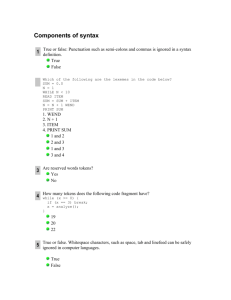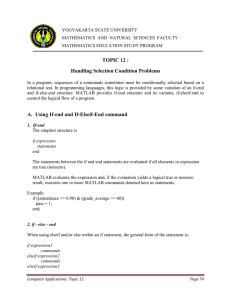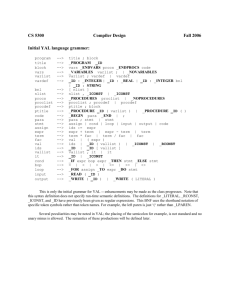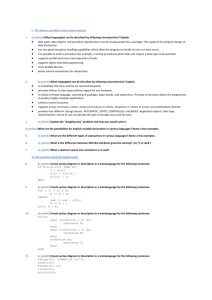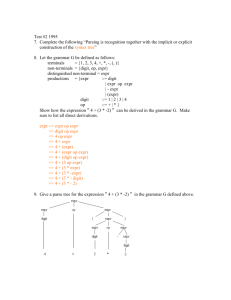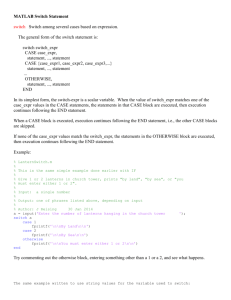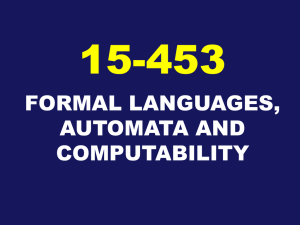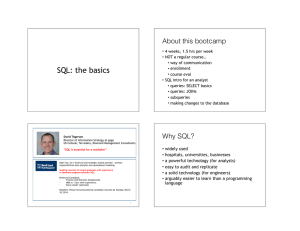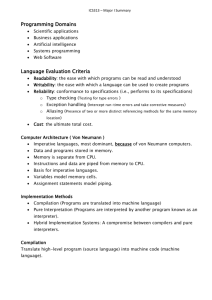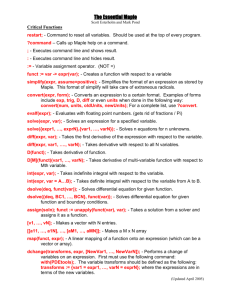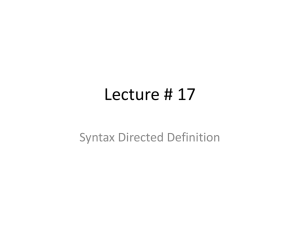331 Final
advertisement
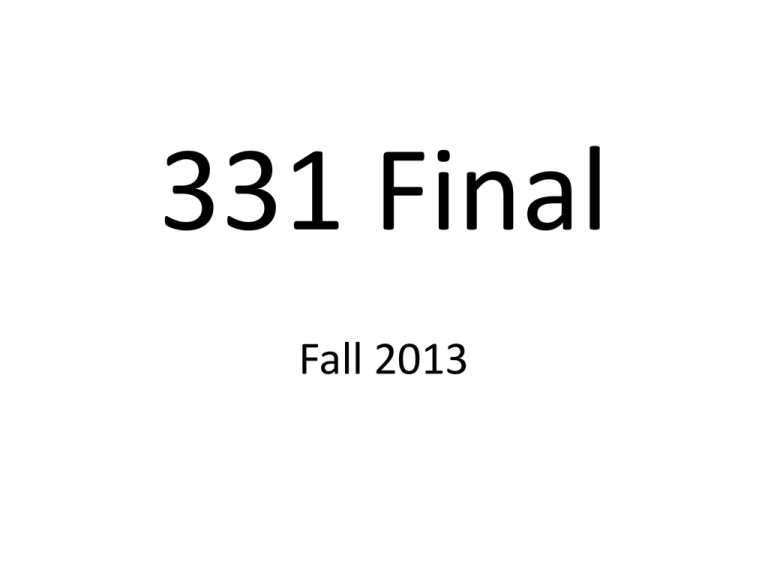
331 Final
Fall 2013
Details
• 3:30-5:30 Monday, December 16
• ITE 229 (this room!)
• Comprehensive with more emphasis on
material since the midterm
• Look at the review page
– We may update this, so watch your email
• Study past finals and midterm exams,
especially those from fall 2008, spring 2010,
and fall 2010
Readings
• Read all assigned material from book and
schedule
• From the text: chapters 1, 2, 3, 4, 5, 9 and 16
• From the web: read things marked as read on
the schedule
For Help
•
•
•
•
Think
Look in our text
Search the Web
Use the discussion forum to post questions or
ask for clarification
• Seek help from the TAs
• Email me
Example Problem
Briefly describe the language this grammar
defines in a sentence or two. Assume that the
start symbol is S and that any symbol found only
on the right hand side of a production is a
terminal symbol.
S -> B A
S -> a
B -> S A
A -> a
Example Problem
Briefly describe the language this grammar
defines in a sentence or two. Assume that the
start symbol is S and that any symbol found
only on the right hand side of a production is a
terminal symbol.
S -> a | aa
S -> a X
S -> b S b
S -> b | bb
X -> S a
EBNF to BNF
Assume that you have already been given grammars for
the non-terminals <iden> and <expr> which represent
identifiers and expressions, respectively. Rewrite the
following EBNF grammar in BNF. You may create new
non-terminal symbols if you wish.
<statement> ::= <iden> '=' <expr>
<statement> ::= 'IF' <expr> 'THEN' <statement> [ 'ELSE' <statement> ] 'ENDIF'
<statement> ::= 'WHILE' <expr> 'DO' <statement> 'ENDWHILE'
<statement> ::= 'BEGIN' <statement> {';' <statement>} 'END'
EBNF to BNF
<s> ::= <iden> '=' <expr>
<s> ::= 'IF' <expr> 'THEN' <s> [ 'ELSE' <s> ] 'ENDIF’
<s> ::= 'WHILE' <expr> 'DO' <s> 'ENDWHILE’
<s> ::= 'BEGIN' <s> {';' <s>} 'END’
Becomes
<s> ::= <iden> '=' <expr>
<s> ::= 'IF' <expr> 'THEN' <s> 'ENDIF’
<s> ::= 'IF' <expr> 'THEN' <s> 'ELSE’ <s> 'ENDIF’
<s> ::= 'WHILE' <expr> 'DO' <s> 'ENDWHILE’
<s> ::= 'BEGIN' <ses> 'END’
<ses> ::= <s>
<ses> ::= <s> ; <ses>
Example Problem
(a) Draw a DFA for a real number that satisfies the following description, using
the conventions above.
A real number can start with an optional sign which can be "-" or "+" and
consists of an integer part followed by a decimal point followed by a
fractional part. The integer part can be a single zero or a non-empty sequence
of digits that does not start with a zero. The fractional part is a non-empty
sequence of digits. Positive examples include 0.0, +0.0, 0.12, 12.3 and -9.87 .
Negative examples are: 0, 01.2, -01.2, 3. and 42 .
Identify the start state and all accepting states and label every arc. Since this
is a deterministic and not a non-deterministic finite automaton, every arc
must have a label which can not be epsilon.
(b) Write a regular expression that corresponds to the DFA, making it as
simple as possible. Use parentheses to ensure proper scope or for clarity.
Example Problem
Assuming that we’ve done (define x '((1 (2)) (3)))
give a Scheme expression using only the
functions car and cdr and variable x that returns
the 2 in the list
Example Problem
Common Lisp has a built-in function maplist. The two-argument
Scheme counterpart that could be written as follows:
(define (maplist f l)
(if (null? l)
null
(cons (f l) (maplist f (cdr l)))))
• What will (maplist car '(1 2 3)) return?
•What will (maplist cdr '(1 2 3)) return?
• What will (maplist (lambda (x) x) '(1 2 3)) return?
•What will (maplist length '(1 2 3))
Example Problem
Consider a function insert with three args: an arbitrary expression, a proper list, and a
positive integer. The function returns a new list that is the result of inserting the
expression into the list at the position specified by the third argument. Note that
positions begin with zero. If the integer is greater than the length of the list, put the
expression at the end.
> > (insert 'X '(a b c) 3)
(a b c X d)
> > (insert '(X) '(a b c) 1)
(a (X) b c)
> > insert 'X '(a b c) 0)
(X a b c)
Here is an incomplete definition of the function. Give code expressions for <S1>, <S2>
and <S3> that will complete it.
(define (insert expr lst pos)
;; Returns a list like proper list lst but with expr inserted at the position given by
;; positive integer pos. e.g.: (insert 'X '(a b c) 2) => (a b X c)
(cond (<S1> (cons expr lst))
((null? lst) <S2> )
(else <S3>)))
